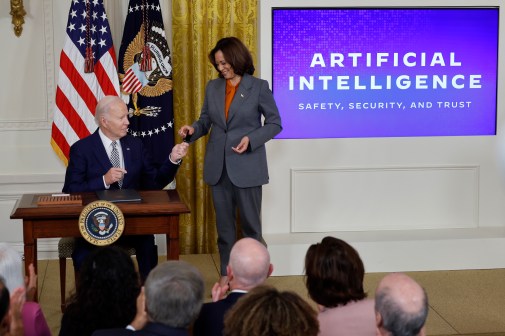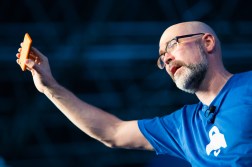What feds can learn from a Silicon Valley CEO

Box co-founder Aaron Levie and U.S. Deputy Chief Technology Officer Ryan Panchadsaram spoke at an ACT-IAC forum Tuesday. (FedScoop)
CAMBRIDGE, Md. — Technology innovators from opposite sides of the Washington-Silicon Valley technology axis squared off on the state of public and private sector innovation, concluding at an industry forum Tuesday that talent and speedier development cycles were crucial for both sectors.
Box co-founder Aaron Levie and U.S. Deputy Chief Technology Officer Ryan Panchadsaram each had plenty to say about the challenges IT leaders face in accomplishing the government’s work.
Speaking at the Management of Change conference, sponsored by the American Council for Technology and Industry Advisory Council, or ACT-IAC, Levie said innovative technology services are proliferating at a stunning rate in the private sector.
“There are new startups coming every single day. The big challenge — and the opportunity — is how do you get those same innovations in the private sector to be able to enter into the government space?” Levie said.
Beyond that is how to get federal agencies to embrace the shift in the way organizations increasingly buy technology, contracting enterprise IT services rather than purchasing IT products.
“What’s happening in the tech space,” Levie said, is “it used to be you started a software company, you started a hardware company, you sold a thing. You sold a piece of software or hardware that got deployed. The customer was then responsible for integrating and managing that. If two or three years later you had a new version of that, or updated that, you tried to resell that.”
With the emergence of software as a service 15 years ago, and companies like Salesforce.com, that model began to change, now with companies routinely updating their software offerings daily or weekly.
Levie said Box’s 250 engineers deliver software enhancements daily, working in organized two-week sprints, which, in turn, are generally batched in eight-week cycles. The only element with longer term planning cycles, he said, is their underlying architecture.
Levie chided organizations, and government agencies by implication, that continue to adhere to the old model of software acquisition.
“The amount of products that are running at agencies that have the [version] number 2003, or 2007 is pretty massive,” he said, noting that a 2003 product was designed 15 years ago.
“That’s a big problem,” he explained as customers become accustomed to working with organizations that are able to operate using software that is continually updated and improved. With technologies like Box’s, he said, “you’re getting the May 20 version of our technology – tomorrow.”
Levie didn’t pull any punches, saying current government acquisition practices remain a big impediment for agencies and IT program leaders wanting to innovate.
It’s incumbent upon agencies and their IT acquisition teams to rethink how they buy technology. “You’re not getting a thing, you’re getting a service. It needs to be consumed like a service. And it needs to bought and utilized like a service.”
One of the big challenges the private sector as well as the public sector is running into is how to attract top talent if their organizations appear slow to change, both IT leaders said.
Panchadsaram in many ways represents how government is trying to correct that.
A founder of a health care startup, Panchadsaram came to Washington as a Presidential Innovation Fellow in 2012 and went on to work on the Healthcare.gov recovery team. Now he’s helping the White House try to attract tech talent who might have once overlooked the value of working for government.
“For many technologists, the option of working for government has never been put out there,” he said. “We’ve never asked for their help. My hope, and our hope at the White House, is we need to create a culture of service from technologists all across the country — can you spend a year or two years or even six months working for the government? And if you do that, we think we can actually upgrade government at all levels,” he said.
The administration’s outreach to the technology community for top-flight digital talent has already brought in 150 people to work on IT acceleration projects, he said.
Levie countered that the completion for talent, and the changing expectations among up-and-coming tech innovators, has grown fiercer than ever.
“There’s a crisis going on in the private sector, which is how do you take a business that’s 30, 50 or maybe 100 years [old], and infuse new talent into their organization. And they’re realizing technology is inseparable from the answer to that question.”
The challenge of how to speed up innovation and technology deployments was a central theme of the ACT-IAC conference, which included presentations from the head of Uber’s technology services, Chris Craven; PBS’ vice president for IT, Chris Contakes; and the former CIO of Australia Ann Steward. The conference attracted more than 500 federal government and industry IT leaders, according to the conference’s organizers.




